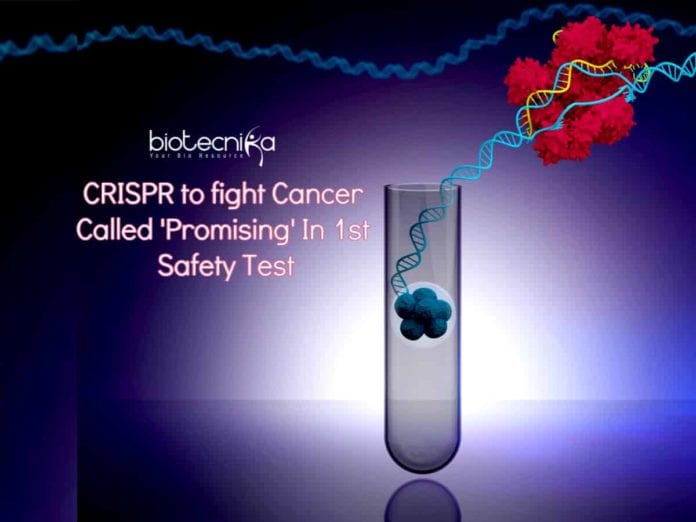CRISPR to fight Cancer Called ‘Promising’ In 1st Safety Test
CRISPR, The powerful gene-editing technique, has now raised a lot of hope in recent years for its vibrant potential to offer new ways to treat many diseases, including cancer. But until now, researchers have released very little information about the results of safety tests in patients.
On Wednesday, scientists revealed data from their first study involving U.S. cancer patients who had received cells genetically modified with CRISPR technology.
The highly anticipated study results, while quite preliminary, seem to be encouraging, researchers say.
This is a very important first step of the research said Dr. Edward Stadtmauer who is a professor in oncology at the University of Pennsylvania and the current study’s principal investigator. He added that they hope this is the beginning of the next generation of engineering cells to help many different diseases and tumors.
Stadtmauer stresses that this trial was not designed to determine whether the approach actually works — only whether it is safe & feasible.
He added this treatment is not ready for prime time, but it is definitely very promising.
Other scientists agree.
Jennifer Doudna of the University of California, Berkeley, who has contributed to the
discovery & development of CRISPR techniques said that she is very much excited about the study results.It is definitely an important step on the path toward using CRISPR-Cas genome editing in patients. And it shows the potential of this technology to be a safe & effective therapy, she added.
Dr. Michel Sadelain, who is doing related research study at Memorial Sloan Kettering Cancer Center, New York, said he is glad to see the gene-editing move into the clinic this way, though he stresses that the patients will have to be followed much longer to gain the confidence that this approach is truly safe.
Sadelain added we want more patients and also a longer follow-up to really make a call that the use of CRISPR gene editing is safe. But the data are certainly encouraging. So far, so good- but still early.
Researchers in China have been trying to use CRISPR to treat cancer patients for years but have released only very little information about their research work. Another US study involving CRISPR for cancer recently started recruiting patients.
The researchers are all part of the first wave of research moving CRISPR gene editing out of the laboratory and into patients. Doctors have just begun testing CRISPR gene editing for the blood disorders sickle cell disease and beta-thalassemia. And researchers plan to soon try using CRISPR to edit genes inside the cells of the human body as a way of treating a genetic form of blindness.
This cancer research study, which will be presented next month at the meeting of the American Society of Hematology in Orlando, Fla., involved just 3 patients — 2 with multiple myeloma & one with sarcoma.
The patients who had received infusions of about 100 million of their own immune system cells that had been removed from their bodies & were genetically modified in a laboratory.
Stadtmauer said the approach aims to combine CRISPR with another of the most exciting advances in medical research in recent years i.e, to harness the immune system to fight against cancer.
The last decade has really been a revolution in the immunotherapy to fight cancer, Stadtmauer said. Researchers have learned how to harness the immune system to fight against cancer -to create these miraculous cells that are infused into the patients as living drugs to treat cancer.
While that approach has produced new treatments for some leukemia and lymphoma patients, those genetically engineered living drugs either do not work for many cancer patients or eventually stop working.
That prompted the researchers to turn to CRISPR gene editing.
The team wanted to see if they can even further improve these study results by giving these cells sort of superpowers to proliferate even better, to stay in the patients better as living drugs and to potentially attack even more directly the tumor, Stadtmaueradded.
Researchers used CRISPR to knock out 3 genes in the cells to enable the cells to attack cancer cells more aggressively. Scientists also used a more traditional form of genetic manipulation to insert into the cells a gene that would more specifically target the patient’s cancer cells.
The patients were treated in January, April & August, with the first patient being followed for at least 6 months. The cells appear to be doing what they hoped they would do without producing any significant adverse effects, the scientists said.
The next step, researchers say, is to treat additional patients as part of a trial that will eventually involve about 18 participants who have sarcoma, melanoma/ myeloma.
Laurie Zoloth, Bioethicist of the University of Chicago applauded the team for its cautious approaches.
Doing it slowly, doing it with a very small group of patients and making no grandiose claims is exactly what you would like to see in a trial like this, said Zoloth, who helped review the research study for the National Institutes of Health.
Zoloth noted that the University of Pennsylvania was the site of a different medical experiment that ended in tragedy in the year 1999, when a teenage volunteer, Jesse Gelsinger, died from complications of the procedure he had undergone. That had set back the field of gene therapy for many years.
Editor’s Note: CRISPR Takes its First Steps In Editing Genes To Fight Cancer, CRISPR to fight Cancer Called ‘Promising’ In 1st Safety Test, University of Pennsylvania






























